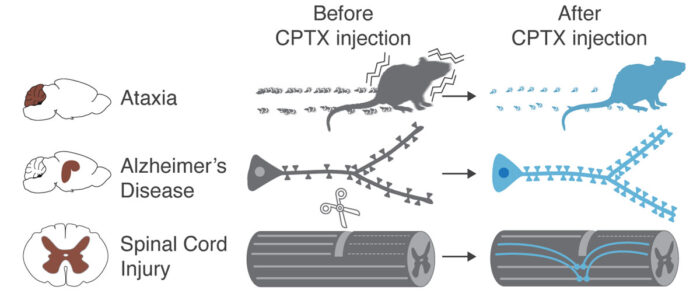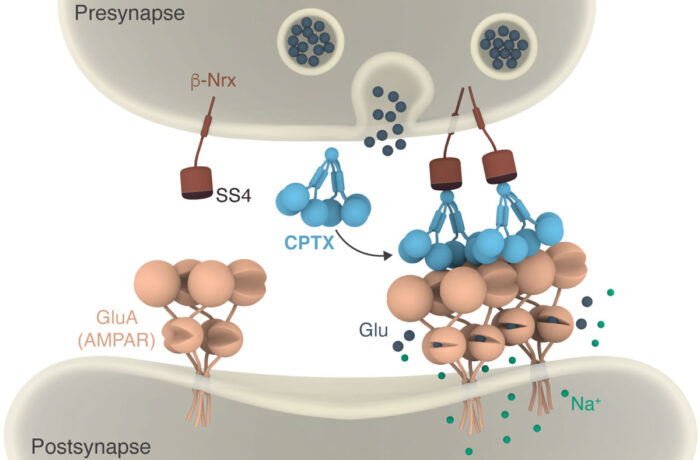Protein structures have been used to design and create an artificial molecular bridge that can repair neuronal circuits in models of disease and injury

The human brain contains an enormous number of connections, known as synapses, within a vast network of neurons. Damage in the brain or spinal cord often involves loss of these connections, which is also associated with many neuropsychiatric and neurological disorders. A collaborative team of researchers that includes Radu Aricescu’s group, in the LMB’s Neurobiology Division, has now created a molecule that can restore these lost connections in multiple animal models of disease, including Alzheimer’s.
Building and remodelling of synapses occurs throughout life under the control of synaptic organiser proteins. Some of these synaptic organisers directly connect proteins within the membranes of neurons to form molecular bridges that span synapses. There are many different synaptic organiser proteins that have diverse specific functions in terms of the types of neurons they connect and the regions of the brain they are active in. Radu’s group, working together with collaborators in Japan and Germany, wondered if they could use their knowledge of synaptic organiser structures to design artificial molecules that could reverse loss of synapses.
Jonathan Elegheert and Amber Clayton, in Radu’s group when he was based in Oxford, solved a series of synaptic organiser structures that enabled an accurate definition of domain boundaries and interaction determinants for specific pre- and post-synaptic receptors. By combining structural elements from the organiser proteins cerebellin-1 and neuronal pentraxin-1, as well as motifs that ensure desired oligomeric states, Radu designed a first synthetic synaptic organiser called CPTX to bridge presynaptic neurexin and postsynaptic AMPA receptors and induce formation of excitatory synapses.

Following successful in vitro validation experiments, Kunimichi Suzuki in Michi Yuzaki’s lab at Keio University, Inseon Song in Alexander Dityatev’s lab at DZNE Magdeburg and Hiroyuki Sakura in Kosei Takeuchi’s lab at Aichi Medical University tested CPTX in mouse models of disorders involving neuronal loss and degeneration. As well as observing reconnection of synapses, the team were able to measure improvements in behavioural tests, with restored motor coordination in cerebellar ataxia, better performance in memory tests in mouse models of Alzheimer’s disease, and improved movement after spinal cord injury.
Movie of a mouse with cerebellar ataxia before and after CPTX injection.
As well as having the potential to lead to therapies for the conditions investigated, this work is a prototype of how structure-guided approaches can be used to repair neuronal circuits more generally, opening the way to many applications in neuronal repair and circuit engineering and remodelling. For example, CPTX was designed to restore connections that send excitatory signals, but the same principle could be used to make inhibitory versions or to remove connections in disorders like epilepsy. Kunimichi Suzuki, now based in Radu’s group at the LMB, is currently developing second generation synaptic organisers that will be tested by the team in multiple animal models.
The work was funded by UKRI MRC, the Human Frontier Science Program, the Japan Society for the Promotion of Science, the Keio University Grant-in-Aid for Encouragement of Young Medical Scientists, the Keio Association Grant-in-Aid, the Astellas Foundation for Research on Metabolic Disorders, the Daiichi Sankyo Foundation of Life Science, the AMED, the Japan Science and Technology Agency, the Takeda Science Foundation, Marie Skłodowska-Curie Actions, the University of Bordeaux Initiative of Excellence, the ERC, the EU, and the Bundesministerium für Bildung und Forschung.
Further references
A synthetic synaptic organizer protein restores glutamatergic neuronal circuits. Suzuki, K., Elegheert, J., Song, I., Sasakura, H., Senkov, O., Kakegawa, W., Clayton, AJ., Chang, VT., Ferrer-Ferrer, M., Miura, E., Kaushik, R., Ikeno, M., Morioka, Y., Takeuchi, Y., Shimada, T., Otsuka, S., Stoyanov, S., Watanabe, M., Takeuchi, K., Dityatev, A., Aricescu, AR., Yuzaki, M. Science (Epub ahead of print)
Radu’s group page
Michisuke Yuzaki’s group page
Alexander Dityatev’s group page
Kosei Takeuchi’s group page
UKRI MRC press release